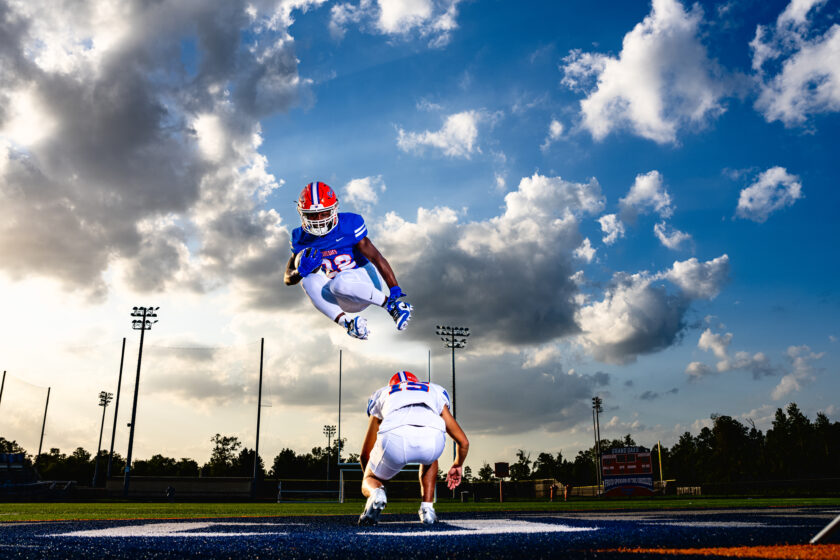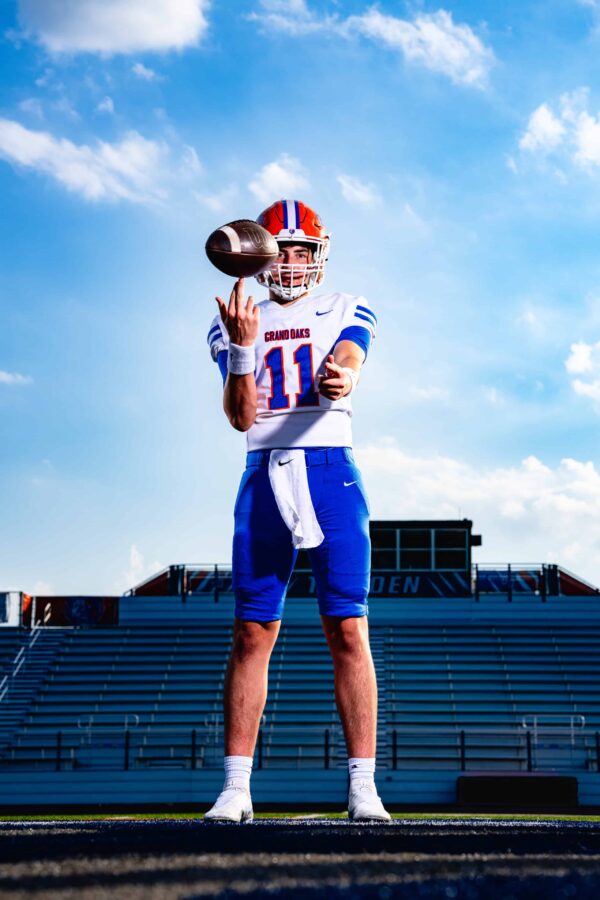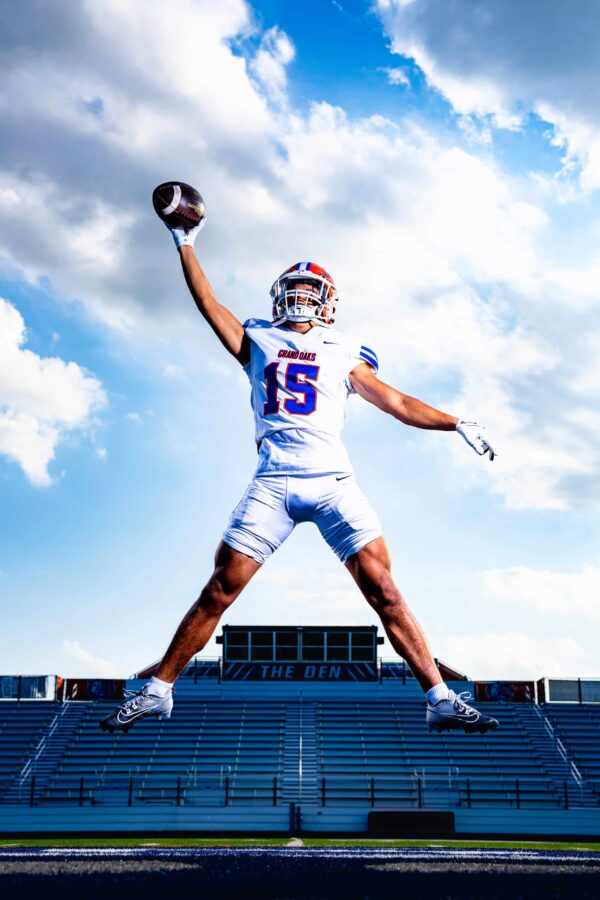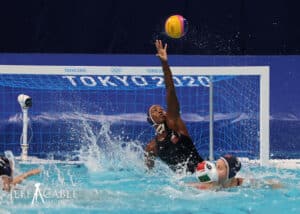Pro tips for dynamic videos from high school sports photographer Seth Fontenot.
September 4th, 2024
Photo credit: Seth Fontenot Photography
Seth Fontenot is a sports photographer and videographer based in Texas. We sat down with Seth to learn how he got into sports videography, how he keeps his videos fresh and creative, video storyboarding tips, and more.
How did you get started in sports photography and videography?
I had an opportunity to go to a football game where I could go down to the sideline and shoot live game photos, and I fell in love with it. I felt the energy of the players, the speed of the game, and I wanted to bring that to photography and share it with others so they could feel that same feeling of excitement. The way I got started in videography for sports was really an evolution of my photography.
I had gotten comfortable shooting photos, and I started experimenting with the video and found that I had a big passion for making hype videos. One thing that really excites me about sports photography is I’m around a lot of high school students who are really trying hard to get to the next level and play at college. So I try to find the way that colleges are representing their players, and I bring that to the high school level.

What is your pre-production process for creating sports hype videos?
When I’m planning hype videos for a sport, there are a number of things that I think about beforehand. I’ll do a series of storyboarding where I will come up with a vision for the shoot and what kinds of shots will help me reach that vision.
I’ll do some research by going on to YouTube or Instagram and watching college-level hype videos. That’s really where my motivation comes from. My goal is to bring the high school videos up to the college level.
I also leave room to feed off of what the players are giving me on the set. I’m not always aware of what might be in style or trending, so I like to ask the student-athletes to show me what ideas they may have to bring to the shoot. I’ll work with their ideas and stitch that together with what I planned.
Usually, it works out that I plan out about two-thirds of the shoot, and I have an idea of what to expect. In this last part of the shoot, I take it in stride and just capture what’s happening in the moment.

What essential equipment do you always bring for a video shoot (besides your camera)?
One of the most important tools I have for capturing video is a gimbal. A gimbal allows me to hold the video camera in a much more stabilized way so that I can move, run, and I am able to match the speed of movement around me.
Another essential piece of equipment that I bring to all my video shoots is providing music. I bring a very large Bluetooth speaker out on set. It’s important that I set the right vibe for the players so that they have the right energy level. This really translates into how they perform in the video and how comfortable they are. A key piece of making these videos come to life is having the kids feel in the right mindset, and music is a big part of that.

How do you approach lighting your sports videos?
If I’m shooting a sports video of live footage on the sideline of a game, I don’t use any lighting. I’m limited to natural light, which has its own challenges in and of itself, whether harsh sunlight or stadium lights. In general, I’m using natural ambient light around me.
When I’m shooting a hype video, I have a lot more leeway with controlling the lighting, and the style that I typically go for is more of a dark, dramatic feel. To do that, I usually work in a low-light environment, like a gym where I can control the lights and turn them off, and then I have my series of lights. I’ll use naturally white-balanced lights in combination with RGB lights.
One of my favorite ways of lighting scenes is using RGB tube lights so that I can match the colors to the school or the sport and the background and have a clean white light in the foreground to light the subject. That gives a really good pop, where there’s a lot of black and darkness behind the subject, and the subject is bright and kind of pronounced in front of that scene.

What is your approach to camera movement, and how do you apply this to your work?
When I’m editing, I like to cycle between still shots to full-on movements with a gimbal. I find that when watching a video, it’s more interesting if there’s contrast between the movements. So I don’t want to stay still for the entire video, and I also don’t want to be moving for the entire video.
In addition to movements for videos, one key piece that I pay a lot of attention to is the speed of the footage. I almost always shoot at 120 frames per second (fps), which allows me to slow it down back to 24 frames. By having that difference in [frame] speed, I can slow things and speed things up, giving the feeling and effect of movement without actually having physical movement.
All those things play into the story feel in a video, and how exciting and how connected you feel to the motion of the sport that you’re capturing.

What are some of the challenges you face as a volume photographer?
These shoots have over fifty to two hundred people in a single setting. There are a lot of logistics for people being on time, following directions, collecting payments, and answering questions from parents.
Beyond the shoot itself, there is a significant amount of time invested in editing and building templates by adding names and graphics, uploading these, and getting them shared in a timely manner.
Part of the business is sometimes dealing with parents in a school setting. You can find yourself interacting with many parents who might have questions or asking if you can change things about their kids’ photos that may not be entirely realistic. But part of being a photographer is answering those questions, staying professional and polite, and still getting the work done.
One pain point for photographers is the amount of communication we have with our customers after a shoot. One of the ways that Zenfolio helps alleviate this is by having a series of automated emails that help inform the customer of the order status. When an order is initially placed, a confirmation is sent. There are also updates on printed orders; a separate email will be sent when the shipping is ready. It will send a separate email with a digital download link if it’s a digital download.
It cc’s me on all of those automated emails. So, for my accountability, if I ever have a customer reach out and say they never got what they ordered, I can look through my emails and say, “Here was the email!” and forward it to them.

How has your website helped you curate and share your portfolio with prospective clients?
It gives instant credibility to have a polished website where I can show my portfolio and have a good external identity to share with people I haven’t met who may have found me through social media or other means.
Another benefit of using the website is the different demographics I work with. I have a lot of traction on social media from students, but booster club members and parents are more likely to use a website than they are Instagram. So, having my Zenfolio portfolio online, in addition to my social media, helps me cover the spectrum of how to reach my prospective clients.
The features from Zenfolio that help my sports photography business the most are the flexibility around how I manage orders and payments. The ability to customize packages, price points, and print sizes on a per-album basis gives me a lot of flexibility. The events and shoots I cover have different needs, price points, and products to sell. I like being able to manage that and apply that on a per-album basis within my website.
Seth’s client gallery delivery workflows:
Before using Zenfolio, my business relied on things like Google Drive and Microsoft OneDrive. I would do a shoot, and then I would email links out to my own personal Drive folders. And there was no interface for viewing the photos, purchasing, or anything like what I have on my website. I would have to email links and select photos, and there was just a lot more back and forth.
Now that I have my website, it helps a lot with the logistics and communications. Clients and customers can purchase directly from the site without having me intervene, discuss or answer questions. I have my website set up with a lot of automated purchasing, and it gives me time back so I can focus on editing and doing new photoshoots.
One place for everything from proofing to selling.
Share and sell your photos directly from mobile-friendly, interactive online galleries designed to impress your clients.
In the back end, I have the ability to create folders and albums in a very clean, aesthetically pleasing way so that a large volume shoot, which may have a breakdown of different grade levels and different team levels, still results in an easy way to organize the photos and share that back with parents and the school. One of the most important things for me when sharing volume galleries is how clean they look when they’re shared.
You want to have a site like Zenfolio that optimizes the view whether you’re on a PC, whether you’re on an iPad, or a mobile device. What is important is the way the galleries are laid out, the way you can scroll through, and the way the screen is filled up–that interaction makes all the difference for the first impression when clients are looking at the photos.
In addition to that, having the customization to apply different price packages or print packages on a per-shoot basis helps me stay organized. When I have a shoot that might need to have prints done in a certain size versus another school that has a different preference, I can keep those price lists organized and apply them to folders or galleries in different schools. I can stay consistent and know that when an order comes in from a parent, I don’t have to be worried that they might accidentally order something that’s not right for that school because that functionality is already customized.
Check out Seth’s online portfolio and follow him on social media for more inspiration.
For a behind-the-scenes look at some of Seth’s video shoots, watch our full interview:



